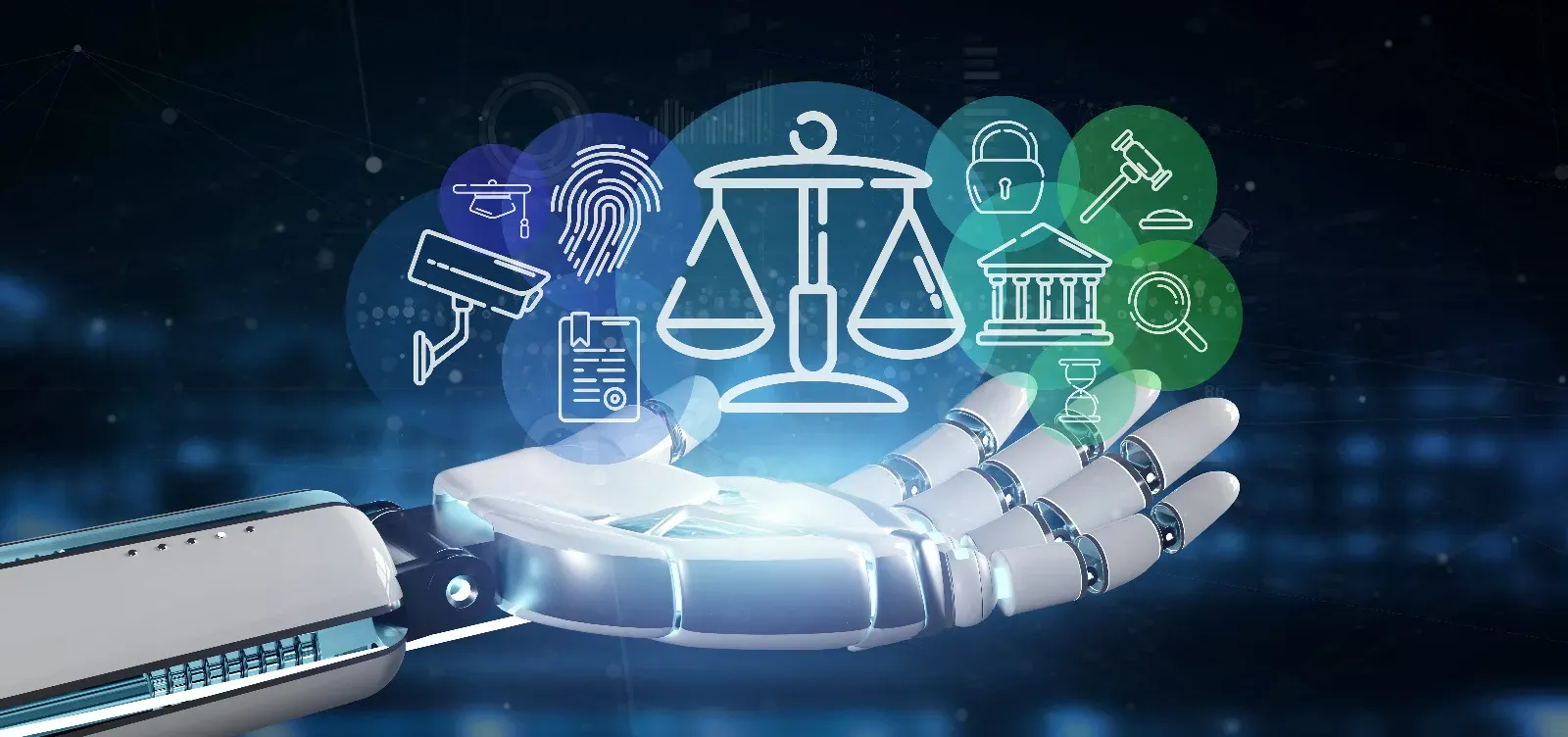AI in Criminal Justice is revolutionizing the way legal systems operate, blending advanced technology with traditional practices to potentially enhance fairness and efficiency. As law enforcement agencies incorporate innovations like facial recognition technology and predictive policing, the implications for public safety and civil rights are profound. While these tools promise to streamline operations, there is a growing discourse surrounding bias in AI when applied to criminal justice, raising fundamental questions about accountability and ethical deployment. Advocates argue that AI can alleviate burdens on overwhelmed court systems and police forces, yet critics fear it may exacerbate existing disparities and infringe on privacy rights. The ongoing conversation around criminal justice reform highlights the need for careful examination of AI’s role, ensuring that technological advancements serve to uplift justice rather than undermine it.
The integration of artificial intelligence within legal frameworks signifies a pivotal shift in how justice is administered and enforced. Various innovations—from advanced surveillance systems to data-driven law enforcement strategies—are reshaping the landscape, aiming to improve outcomes for victims and defendants alike. However, the challenge remains to mitigate biases inherent in AI algorithms that could lead to unfair treatment of certain demographics. With the potential to enhance both law enforcement efficiency and judicial processes, the call for comprehensive guidelines on best practices is more crucial than ever. As discussions surrounding technology’s role in the legal sphere evolve, stakeholders must remain vigilant against pitfalls while advocating for progressive reforms.
The Impact of AI in Criminal Justice
Artificial Intelligence (AI) is beginning to change the landscape of the criminal justice system, offering both promising solutions and significant challenges. Its applications span from predictive policing, where algorithms analyze data to predict potential crime hotspots, to facial recognition technology, which law enforcement uses to identify suspects. These technological advancements can streamline processes, allowing officers to allocate resources more efficiently. However, this efficiency introduces concerns about privacy invasion, misuse of data, and potential biases embedded in algorithmic decision-making.
Despite the promise of AI, the deployment of these technologies has often been criticized for perpetuating systemic inequalities. For instance, the over-reliance on AI tools like facial recognition, especially in over-policed communities, raises questions about fairness and transparency in policing. Reports have indicated that these technologies can misidentify individuals, disproportionately affecting marginalized groups. It is essential for stakeholders in the criminal justice system to address these concerns while harnessing AI’s capabilities for better outcomes.
Facial Recognition Technology: A Double-Edged Sword
Facial recognition technology has been one of the most controversial AI applications in law enforcement. Proponents argue that it can enhance public safety by quickly identifying suspects. This technology can significantly reduce the time taken to solve crimes, potentially deterring criminal activities due to the increased likelihood of detection. Nevertheless, the implementation of facial recognition often raises ethical questions. Instances of wrongful arrests due to misidentification highlight the urgent need for clear standards and regulations surrounding its use. Critics assert that its deployment lacks accountability and that it disproportionately impacts minority communities.
Moreover, the ethical implications of using facial recognition extend to societal perceptions of surveillance. Many fear that this technology could lead to an erosion of civil liberties, with law enforcement agencies potentially using it to monitor peaceful protesters or other groups. As public awareness grows, there is increasing pressure on policymakers to establish guidelines that ensure that technology serves the public good without compromising individual rights. The potential for comprehensive criminal justice reform rests on the ability to balance these interests with the insights AI can provide.
Predictive Policing and Community Trust
Predictive policing has emerged as a key aspect of how AI is being integrated into law enforcement. By analyzing historical crime data, algorithms can forecast where crimes are likely to occur, allowing police to allocate resources proactively. This method promises improved efficiency and a potential reduction in crime rates. However, the reliance on historical data raises concerns about embedded biases, often perpetuating a cycle of over-policing in communities of color. Critics argue that predictive policing can reconstruct the very disparities it aims to alleviate, potentially eroding trust between communities and law enforcement.
Building community trust while implementing predictive policing strategies is crucial for their success. Law enforcement agencies must engage with community stakeholders to ensure openness and transparency about how data is used. Feedback mechanisms that allow community members to express their concerns about these practices could help mitigate fears and foster collaboration. For predictive policing to contribute positively to criminal justice reform, a focus on accountability, ethics, and community engagement is essential.
Addressing Bias in AI Systems
Bias in AI remains a significant challenge in the criminal justice sector, where algorithms can unintentionally reinforce prejudiced assumptions. The potential for AI systems to inherit biases from the datasets they are trained on raises alarm bells among civil rights advocates. For instance, facial recognition software has been shown to misidentify individuals from underrepresented groups at alarming rates, potentially leading to wrongful arrests. Addressing these biases requires a concerted effort from tech developers, law enforcement officials, and policymakers to create diverse and representative datasets that reflect the communities being served.
Furthermore, there exists an urgent need for ongoing bias audits and transparency regarding AI applications in law enforcement. Implementing robust oversight mechanisms can help ensure that AI does not inadvertently exacerbate existing inequities. Continuous training for law enforcement personnel about the shortcomings of AI tools, coupled with ethical guidelines for their use, can promote accountability. The path to effective criminal justice reform through AI must prioritize fairness and justice, thereby safeguarding marginalized communities.
Ethical Considerations in AI Implementation
The ethical implications of integrating AI into the criminal justice system cannot be overstated. Stakeholders must grapple with questions around accountability, privacy, and the potential consequences of criminal justice decisions made by AI systems. A key concern is the transparency of algorithms: how they operate, the data they use, and the criteria for their decision-making. Ethically, it is vital to ensure that technology enhances human judgment rather than replaces it, preserving the essential human element inherent in justice.
Additionally, creating a robust framework for ethical AI use in criminal justice should involve diverse perspectives, including technologists, legal experts, and community voices. The Council on Criminal Justice’s task force exemplifies an approach that seeks to embrace innovation while upholding ethical standards. By engaging various stakeholders in discussions about AI in criminal justice, we can work towards solutions that prioritize fairness, protect individual rights, and enhance the overall efficacy of the system.
AI’s Role in Criminal Justice Reform
AI presents an opportunity to spearhead significant reforms within the criminal justice system. By streamlining processes and providing insights through data analysis, AI can help identify areas in need of improvement and aid in developing evidence-based policies. For instance, AI tools can assist public defenders by sorting through extensive evidence, ensuring they are better prepared for case management. Such applications can reduce disparities faced by under-resourced defenders, leveling the playing field in adversarial settings.
Moreover, AI can contribute to broader reform initiatives aimed at reducing recidivism rates. Technologies like AI-generated case summaries can help parole officers focus on key indicators of success for individuals under their supervision, ultimately leading to more successful reintegration into society. As advocates for criminal justice reform push for innovative solutions, it is crucial to engage AI thoughtfully and strategically, ensuring that these technologies foster fairness and protect the rights of all individuals.
Monitoring AI’s Effectiveness in Courts
The integration of AI into court systems raises critical questions about its effectiveness, fairness, and impact on judicial outcomes. With AI technologies assisting in case management and decision-making processes, it is essential to evaluate their performance rigorously. Ongoing assessments can ensure that AI tools improve court efficiencies without compromising the principles of justice. Additionally, establishing metrics to measure success will help identify any unintended consequences of AI usage.
Furthermore, regular monitoring can guide adjustments needed to align AI systems with the fair administration of justice. Collaborations between technologists, judicial leaders, and community representatives can result in feedback loops that enhance AI performance in courts. These partnerships can also address concerns about automated bias influencing legal outcomes, promoting a justice system that is equitable and beneficial for all participants.
Public Awareness and Understanding of AI
Ensuring public awareness and understanding of AI applications within the criminal justice system is vital for fostering trust. As AI technologies become increasingly prevalent, communities must be informed about how these tools are being used in law enforcement and their implications for civil liberties. Public discourse around AI can empower citizens to hold state institutions accountable, advocating for ethical use and demanding transparency.
One effective avenue for enhancing public understanding is through community outreach and educational programs. Engaging local communities in discussions about AI’s role in their lives can demystify these technologies and promote collaborative approaches to justice. Furthermore, initiatives focused on raising awareness about potential biases inherent in AI systems will encourage critical engagement, ultimately leading to stronger advocacy for justice reforms.
The Future of AI in Criminal Justice
Looking ahead, the future of AI in the criminal justice system presents both ample opportunities and significant challenges. As technologies evolve, there is potential for innovative applications that could enhance justice processes. However, it is crucial to remain vigilant about the risks associated with AI integration, especially concerning fairness and accountability. Developing robust frameworks for ethical AI use will be central to achieving a justice system that utilizes technological advancements without compromising civil liberties.
Collaboration between technologists, legal experts, and community advocates will be fundamental in shaping how AI is implemented across the criminal justice spectrum. By fostering dialogues that prioritize transparency and ethical considerations, we can move toward a future where AI aids in criminal justice reform effectively and equitably. The emphasis on collective engagement will ensure that technological implementations serve the interests of society as a whole.
Frequently Asked Questions
What is AI in criminal justice and how is it being utilized?
AI in criminal justice refers to the application of artificial intelligence technologies within the justice system, including law enforcement and court processes. It is utilized in various areas such as facial recognition technology to identify suspects, predictive policing to design patrol routes, and case management in courts to enhance efficiency. While AI has the potential to improve fairness and efficiency, concerns about privacy and bias remain.
How does facial recognition technology raise concerns in AI in law enforcement?
Facial recognition technology, a crucial aspect of AI in law enforcement, raises significant concerns regarding accuracy and bias. Studies have shown that such technology often misidentifies individuals, particularly among Black communities, leading to a higher rate of wrongful arrests. These issues highlight the critical need for accountability and standards in deploying facial recognition systems in the criminal justice system.
What are the implications of predictive policing in AI in criminal justice?
Predictive policing, which uses AI algorithms to forecast criminal activity, can lead to intensified surveillance and policing in over-policed neighborhoods. This practice risks reinforcing existing biases within the criminal justice system rather than alleviating them. As a result, critics emphasize the need for careful implementation and ethical guidelines to ensure that AI does not exacerbate social inequalities.
What measures are being taken to address bias in AI in criminal justice?
To tackle bias in AI within the criminal justice system, initiatives like the Council on Criminal Justice task force have been established. This group aims to analyze how AI can be used ethically while minimizing the risk of perpetuating biases. By bringing together experts in technology and criminal justice, the task force seeks to develop recommendations for safe AI integration that ensures fairness and accountability.
Can AI contribute positively to criminal justice reform?
Yes, AI has the potential to contribute positively to criminal justice reform. Tools developed by startups like JusticeText aim to level the playing field for public defenders by efficiently sorting through large amounts of evidence. Such AI innovations can enhance case management, provide accurate summaries for parole officers, and assist in identifying diversion program candidates, ultimately improving the justice process.
How can policymakers ensure the ethical use of AI in criminal justice?
Policymakers can ensure the ethical use of AI in criminal justice by developing clear standards and oversight mechanisms. This involves establishing guidelines for AI deployment that prioritize transparency, accountability, and privacy protection. Additionally, collaboration between tech experts and criminal justice practitioners is essential to inform policy decisions and safeguard against the potential harms of AI.
What challenges does AI present to privacy in the criminal justice system?
AI technologies pose significant privacy challenges in the criminal justice system, especially through prevalent surveillance tools. The widespread use of facial recognition and data analysis can lead to intrusive monitoring of individuals, raising concerns about civil liberties and the potential for misuse. It is crucial to implement robust privacy protections and regulations to uphold individual rights amid growing AI integration.
What role do public defenders play in the context of AI in criminal justice?
Public defenders are essential within the framework of AI in criminal justice, as they often represent individuals who may not have access to adequate legal resources. AI tools can support public defenders by streamlining case review processes and identifying critical inconsistencies in evidence. By enhancing their capabilities, AI can help ensure fair representation for defendants in the legal system.
What is the future outlook for AI in the criminal justice system?
The future of AI in the criminal justice system will likely involve increased integration of technology in various processes. However, this will necessitate ongoing discussions about ethical usage, oversight, and risk mitigation. As stakeholders work to balance the benefits of AI’s efficiency with safeguarding against bias and privacy violations, a cautious but progressive approach will be crucial for equitable outcomes in the justice system.
| Key Areas of AI Use in Criminal Justice | Positive Impact | Negative Impact | |
|---|---|---|---|
| Facial Recognition | Identifies suspects but can reinforce biases and inaccuracies. | ||
| Predictive Policing | Improves patrol effectiveness but can lead to disproportionate targeting of certain communities. | ||
| Case Management | Enhances efficiency in handling cases, potentially reducing backlog. | ||
| Public Defender Support | Assists with evidence analysis, aiding in fair representation. | ||
Summary
AI in Criminal Justice has the potential to revolutionize the legal system by making it fairer and more efficient. However, as AI technology continues to integrate into various aspects of criminal justice—from policing and courtroom management to supporting public defenders—critical concerns regarding privacy, accountability, and biases must be addressed. While experts acknowledge the benefits AI can bring, there is a pressing need for ethical guidelines and oversight to ensure that its implementation serves justice without exacerbating existing issues.



